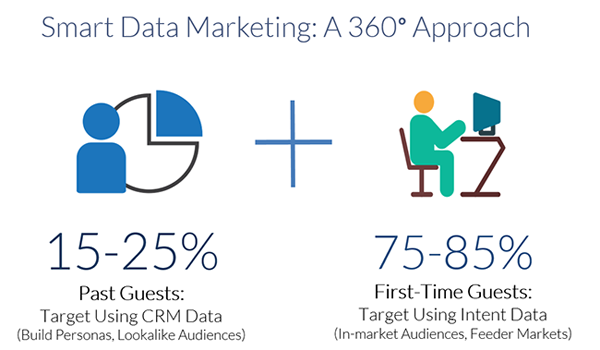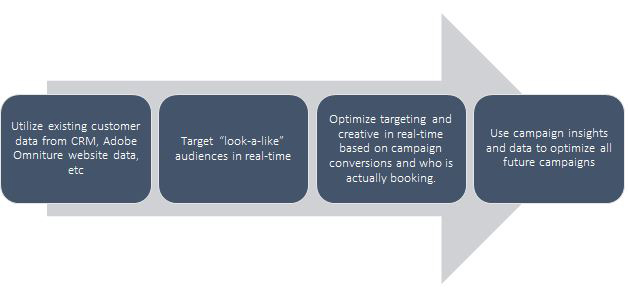By Margaret Mastrogiacomo and Max Starkov
Smart Data vs. Big Data
By now, many hoteliers are tired of hearing about “Big Data” and why they should be utilizing it for customer engagement and marketing.
Many hoteliers assume that utilizing Big Data equals past guest data i.e. CRM Data. At the property level, CRM Data means past guest profile information, past booking history, service preferences, purchasing habits while on property, affiliation with the hotel guest loyalty program, booking channel preferences, preferences for auxiliary services, opt-in email recipients, etc.
In our view, CRM Data is only part of the equation, and only the smaller part of the hotel's customer engagement and acquisition strategy. On average, on any given night, only 15% – 25% of guests at a typical independent hotel are repeat guests, the rest are first-time guests. For branded hotels the percentage of repeat guests at any property is higher, but still below 30% – 40%, not counting loyalty members who have stayed at other properties of the brand.
The more important part of the overall strategy – the one that will result in a much higher percentage of direct bookings – is Intent Data i.e. targeting and engaging travel consumers who are “in market” and planning to visit your property’s destination in the near future. Intent Data is crucial to engage and acquire first-time guests, which generate the bulk of roomnights at the property.
Smart Data Marketing: Closing the 360-Degree Customer Engagement & Conversion Cycle
CRM Data and Intent Data should both be integral pieces of any hotelier’s marketing strategy. Engaging and retaining past guests, frequent guests, and loyalty members is imperative, but if your strategy isn’t utilizing real-time “in-market” targeting that reaches potential guests – travelers who have expressed intent to travel now or in the near future to your destination, you are missing serious revenues and the opportunity to expand and “replenish” your existing customer base on an ongoing basis.
At HeBS Digital we call the balanced utilization of both CRM Data and Intent Data “Smart Data Marketing,” which is at the core of our full-service digital marketing services we provide to our clients, allowing them to “make the most” of past, present and future customer data.
The need to utilize both CRM and Intent Data is illustrated by the following example. Which traveler is more “precious” to your bottom line today? A past guest who hasn’t engaged with your property or brand in a year, or an in-market traveler who just searched flights on a major carrier website arriving in your destination two weeks from now and staying four days? Furthermore, if you can target and convert this traveler in real-time – milliseconds after they researched flights to your destination – with a marketing message featuring the lowest available rate for the exact dates of their stay, we think the answer is clear.
Targeting in-market travelers is a very powerful marketing tactic that reaches users who are the most likely to convert now, while deeply immersed in the decision-making and booking funnel.
Therefore, when diving into your data marketing strategy, it’s important to keep in mind that CRM Data is just one piece of the puzzle, and Intent Data is an equally important piece of the property’s overall marketing arsenal.
While this Smart Data Marketing definition sums up the hotel marketer’s dream scenario, where exactly do we begin to turn this into an actionable strategy?
Smart Data Marketing: Where to Start?
Hotel marketers should start developing their Smart Data Marketing strategy by asking themselves the following question: What percentage of my guests are repeat guests and what percentage are first-time guests? As mentioned, first-time guests provide the majority of roomnights at any given hotel. The percentage of repeat guests vs. first-time guests at any given night vary by property, but a realistic assessment of this ratio will easily guide you on how to focus your marketing dollars.
We believe that past guest data and past guest demographics will always have a place in the marketing playbook. However, hoteliers that understand and respond to travel consumer intent i.e. utilize Intent Data, are better positioned to engage and convert all potential customers, not just past guests or potential customers that fit a historic age and gender profile.
Hotel Marketer’s Best Practices Approach
Smart Data Marketing takes full advantage of “owned data” (past guest data, demographics, website data, etc.) and then layers real-time travel planning insights and Intent Data on top to target in-market users during the travel planning process to your property’s destination. Smart Data Marketing also utilizes programmatic advertising and dynamic rate marketing (DRM).
Process Overview:
As an example, HeBS Digital’s Programmatic strategy focuses on cross-device targeting and marketing insights such as “moment scoring” to ensure we are reaching travelers in key micro-moments when they are most likely to convert. Through our programmatic and DMP (Data Management Platform) partners, we focus on building lookalike audiences based on who is converting, and optimizing creative in real-time based on each individual’s preferences to further ensure we win the booking.
And finally, utilizing Intent Data targeting, Dynamic Rate Marketing allows hoteliers to reach users researching travel to their hotel’s destination while also displaying the best available rate for the exact dates of stay. These direct-response display ads target the user throughout the travel planning journey with a dynamic rate pulled directly from the hotel CRS.
Where in the marketing mix does Intent Data provide the most value?
Your “best guest” shouldn’t just be defined by past guest demographics—your best guest should be defined by travel consumers who are in-market and willing to consider and book your property today. If your marketing campaign reaches out only to past guests or travelers who match your guest profile exactly, but they aren’t currently planning a trip to your destination, it’s a wasted campaign effort and budget.
When targeting lookalike audiences based on CRM Data and demographics (age, gender, business traveler, household income, etc.), you may be reaching the right demographic, but it doesn’t ensure that you are reaching them at the right time when they are actually planning to travel.
Intent Data resolves the above “weakness” of CRM Data by enabling marketing campaigns to target and convert travelers who are in-market and have exhibited purchase intent.
More importantly, building propensity models (predictive analytics) based on CRM Data alone, without taking into consideration Intent Data, only reaches a small percentage of potential guests. HeBS Digital portfolio data shows that when you widen targeting to focus more on purchase intent than simply lookalike audiences based on past guest profile demographics, it increases return by as much as 4 times. This reveals that while CRM data is an insightful glimpse to your current customer, it’s not the best way to predict who will convert.
There’s thousands of potential guests who are planning a trip or vacation to your destination right now, and focusing only on past guests or similar demographics alone will only capture a small percentage of this audience. Building lookalike audiences based on who is actually converting and is currently engaged in the travel planning process i.e. Intent Data, is the right strategy to increase conversions.
Where in the marketing mix does CRM Data provide the most value?
CRM Data provides the most value in customer retention and understanding your customer to build effective multichannel campaigns. CRM Data is a great starting point for understanding your current customers and aiding in research to understand their online behaviors. It also provides great value when it comes to understanding who your most loyal customers are, how they behave online and what they love about your hotel brand.
Using CRM Data together with other “owned data” such as website analytics and marketing insights to build customer personas and take a deep dive into their psychographics and online behaviors is an important step in the multichannel campaign process to craft effective campaign messaging. However, building this persona based on CRM Data alone can hinder campaign success. When building the customer persona, it’s important to also analyze data of who has converted in past campaigns and on what channels to truly build accurate personas and ensure you are reaching the right audience. CRM Data is also a great way to retain customers with a robust email marketing strategy.
HeBS Digital utilizes CRM Data, First-Party Intent Data, and website insights to build multichannel campaigns:
Action Plan to Launching Your Smart Data Marketing Strategy
Now that we’ve explored the importance of utilizing both CRM Data and Intent Data in your marketing campaigns, here are our tried-and-true action steps to set your Smart Data Marketing strategy on the path to success:
1. Utilize “Owned Data” in the Planning and Ideation Phase of Your Marketing Campaigns. Use “owned data” such as CRM Data, website analytics and marketing insights to create the targeting and customer segment objectives of your multichannel campaigns and marketing strategy. Focus your propensity modeling based on who is actually converting once campaigns are live to drive optimal returns. 2. Utilize CRM Data to build Customer Personas. Building Customer Personas allows you to understand your target segment more intimately and get a better understanding of their motivations, online behaviors, passion-points, and what ultimately connects them to your hotel brand on both a functional and emotional level. These Customer Personas ensure that your multi-campaign messaging will resonate with the target segment and drive higher returns. 3. Utilize DMPs (Data Management Platforms) to identify customer personas and target lookalike audiences based on CRM Data. Make sure to also analyze data of who has converted in past campaigns and on what channels to truly build accurate personas and ensure you are reaching the right audience and demographics. 4. Utilize Intent Data-Focused Targeting Strategies. Utilize in-market targeting throughout your marketing initiatives (such as RLSA targeting, which allows you to personalize your marketing message to users who have already been to your website), and lower funnel long-tailed keywords such as “Downtown Miami Hotel with Pool” across SEM, Google Display Network, and YouTube TrueView campaigns. 5. Partner with Top Travel Ad Networks. Utilize specialized travel ad networks and DSPs (Demand Side Platforms) to capitalize on first-party travel data to reach users in real-time throughout the travel planning journey and booking funnel. 6. Capitalize on DRM (Dynamic Rate Marketing) in your Marketing Strategy. Dynamic Rate Marketing is one of the best tactics for targeting in-market travelers deep within the booking funnel. By reaching users researching travel to your hotel’s destination and displaying the best available rate for the exact dates of stay, you can dramatically increase conversions and direct bookings. 7. Integrate Intent-Rich Programmatic Advertising. Focus on programmatic partners that are intent-focused and have data quantifiers such as “moment scoring” that assigns a score to a user interaction to determine the likelihood that they will convert in that micro-moment. This will ensure you reach the right guest at the right time to capture the booking. 8. Utilize Data and Insights for Campaign Optimization. Learn from campaign results and real-time insights to constantly optimize campaign messaging, targeting, marketing mix, and so on.
Overall, as you explore the role of CRM Data and Intent Data in your marketing strategy, the most important thing to remember is you don’t win new customers with data, you win new customers with the right data strategy. With so much data at our fingertips, customer segmentation and campaign targeting can be an overwhelming and often misguided undertaking. Truly capitalizing on customer micro-moments throughout the booking funnel with cost-effective marketing requires the right partners, planning, and strategy.






